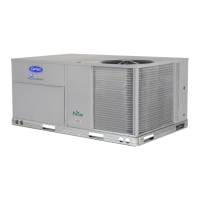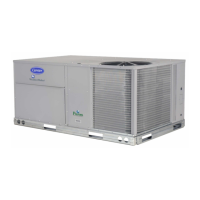111
Transducer Troubleshooting
The electronic control uses 2 suction pressure transducers to
measure the suction pressure of circuits A and B. The pressure/
voltage characteristics of these transducers are in shown in
Tables 93 and 94. The accuracy of these transducers can be
verified by connecting an accurate pressure gage to the second
refrigerant port in the suction line.
Forcing Inputs and Outputs
Many of variables may be forced both from the CCN and di-
rectly at the local display. This can be useful during diagnostic
testing and also during operation, typically as part of an ad-
vanced third party control scheme. See Appendix A and B.
NOTE: In the case of a power reset, any force levels in effect at
the time of the power reset will be cleared.
CONTROL LEVEL FORCING
If any of the following points are forced with a priority level
of 7 (consult CCN literature for a description of priority lev-
els), the software clears the force from the point if it has not
been written to or forced again within the timeout periods de-
fined below:
Run Status Menu
The Run Status menu provides the user with important infor-
mation about the unit. The Run Status table can be used to trou-
bleshoot problems and to help determine how and why the unit
is operating.
AUTO VIEW OF RUN STATUS
The Auto View of Run Status display table provides the most
important unit information. The HVAC Mode (Run Status
VIEW
HVAC) informs the user what HVAC mode the unit is
currently in. Refer to the Modes section on page 41 for infor-
mation on HVAC modes. The occupied status, unit tempera-
tures, unit set points, and stage information can also be shown.
See Table 95.
Run Status
VIEW
HVAC
Displays the current HVAC Mode(s) by name. HVAC Modes
include:
OFF VENT HIGH HEAT
STARTING UP HIGH COOL FIRE SHUT DOWN
SHUTTING DOWN LOW COOL PRESSURIZATION
DISABLED UNOCC FREE COOL EVACUATION
SOFTSTOP REQUEST TEMPERING HICOOL SMOKE PURGE
REM SW DISABLE TEMPERING LOCOOL DEHUMIDIFICATION
COMP STUCK ON TEMPERING VENT RE-HEAT
TEST LOW HEAT
Run Status
VIEW
OCC
Displays the current occupancy status of the control.
Run Status
VIEW
MAT
Displays the current value for mixed-air temperature. This val-
ue is calculated based on return-air and outside-air tempera-
tures and economizer damper position.
Run Status
VIEW
EDT
Displays the current evaporator discharge air temperature
during Cooling modes. This value is read at the supply air
thermistor location (or at cooling coil thermistor array if unit is
equipped with hydronic heating coil).
Run Status
VIEW
LAT
Displays the current leaving-air temperature during Vent and
Hydronic Heating modes. This value is read at the supply air
thermistor location.
Run Status
VIEW
EC.C.P
Displays the current economizer control point value (a target
value for air temperature leaving the evaporator coil location).
Run Status
VIEW
ECN.P
Displays the current actual economizer position (in percentage
open).
Run Status
VIEW
EC2.P
Displays the current position of actuator no. 2 (in percentage
open).
Run Status
VIEW
CL.C.P
Displays the current cooling control point (a target value for air
temperature leaving the evaporator coil location).
Run Status
VIEW
C.CAP
Displays the current amount of unit cooling capacity (in per-
cent of maximum). Compare to staging tables in Appendix C.
Run Status
VIEW
CL.ST
Displays the current number of requested cooling stages. Com-
pare to staging tables in Appendix C and to C.CAP above.
Run Status
VIEW
HT.C.P
Displays the current heating control point, for use with staged
gas or modulating gas control option only (a target value for air
temperature leaving the supply duct).
Run Status
VIEW
HT.ST
Displays the current number of heating stages active (for
staged gas control option only). Compare to following point.
Run Status
VIEW
H.MAX
Displays the maximum number of heat stages available for this
model.
ECONOMIZER RUN STATUS
The Economizer Run Status display table provides information
about the economizer and can be used to troubleshoot econo-
mizer problems. See Table 96. The current position, command-
ed position, and whether the economizer is active can be dis-
played. All the disabling conditions for the economizer and
outside air information is also displayed.
COOLING INFORMATION
The Cooling Information run status display table provides in-
formation on the cooling operation and the Humidi-MiZer
®
operation of the unit. See Table 97.
Current Running Capacity (C.CAP)
This variable represents the amount of capacity currently run-
ning as a percent.
Current Cool Stage (CUR.S)
This variable represents the cool stage currently running.
Requested Cool Stage (REQ.S)
This variable represents the requested cool stage. Cooling relay
timeguards in place may prevent the requested cool stage from
matching the current cool stage.
Maximum Cool Stages (MAX.S)
This variable is the maximum number of cooling stages the
control is configured for and capable of controlling.
Active Demand Limit (DEM.L)
If demand limit is active, this variable will represent the
amount of capacity that the control is currently limited to.
Capacity Load Factor (SMZ)
This factor builds up or down over time (–100 to +100) and is
used as the means of adding or subtracting a cooling stage
during run time. It is a normalized representation of the rela-
tionship between “Sum” and “Z”. See the SUMZ Cooling Al-
gorithm section on page 52.
Temperatures
AIR.T
OAT Outside Air Temperature 30 minutes
Temperatures
AIR.T
RAT Return Air Temperature 3 minutes
Temperatures
AIR.T
SPT Space Temperature 3 minutes
Inputs
RSET
SP.RS Static Pressure Reset 30 minutes
Inputs
REL.H
OA.RH Outside Air Relative Humidity 30 minutes
Inputs
AIR.Q
OAQ Outside Air Quality 30 minutes

